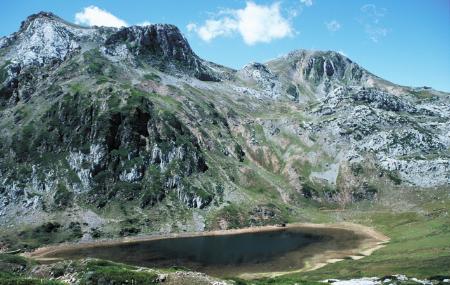
Lake Cerveriz
- Title Somiedo Asturias Centre
- Extension Extension: 10 Ha. km 2
- Maximum elevation Maximum elevation: 1.635 m.
Images
Info
It can be reached by the PR AS-15, Ruta de Los Lagos (Lakes Route), which starts at Collada de la Farrapona, along the mining track that skirts La Cueva lake and La Mina lagoon, which dries out in the summer months. It is a lake of glacial origin whose colour is dark green, tending towards olive in autumn, and the water is colourless, although less transparent than in the neighbouring lakes.
The Saliencia Lakes form part of the Somiedo Lake Complex, declared a Natural Monument.
Plant life
Potamogeton natans is very common in the communities of plants fixed to the bottom and supported by the water in the lake systems of Asturias, but this is the only mountain lake where the greater filigree (Myriophillum) appears. Both plants grow in association down to depths of 2.5 m and coexist with them, together with carophyte algae and another species of Potamogeton.
The white-flowered buttercup is distributed preferentially along the desiccated coastline, in areas with fluvial inputs, as well as Equisetum fluviatile and Eleocharis palustris.
In general, the higher plants are distributed along gently sloping edges with an abundance of clays.
Wildlife
Compared to the other Saliencia lakes, the invertebrate fauna is more abundant.
There are Plumatella repens, the crustacean Gammarus lacustris, oligochaete and hirudine worms (Erpobdella monostriata, Haemophis sanguisuga and DINA lineata), bivalve molluscs, odonates, Sialis, heteroptera (Micronecta poweri), different species of coleopterans, including Ditiscus marginalis, trichoptera, chironomid diptera, plecoptera, amphibians (Triturus alpestris, T. Helveticus, Rana temporaria, Bufo bufo and, on the banks, Alytes obstetricans), brown trout and piscardo.
There are also some mallard ducks.
Map
Location
Access takes place by going up the mining track that skirts the Cueva and Mina lakes until reaching the pass that opens out onto the meadows.

